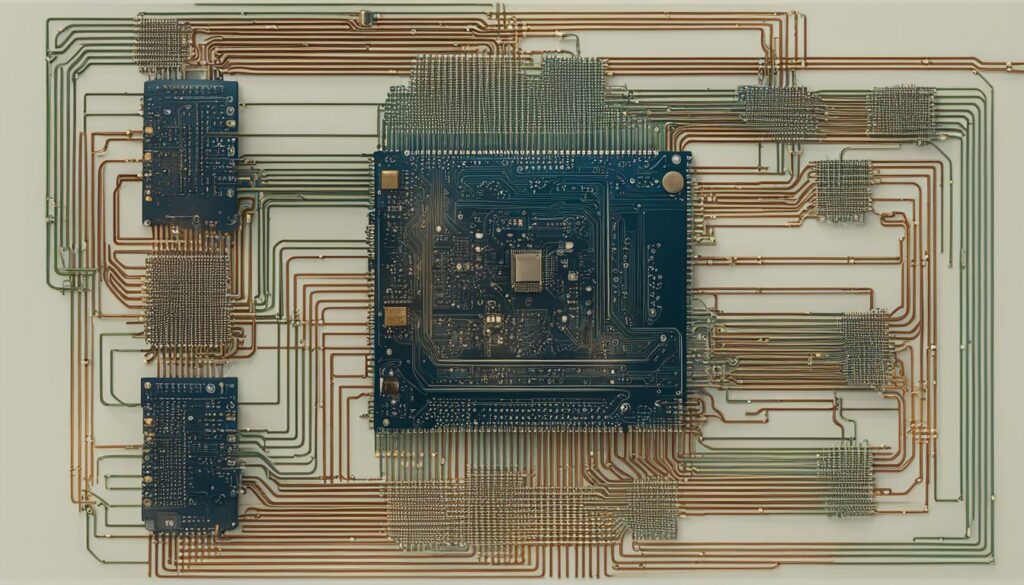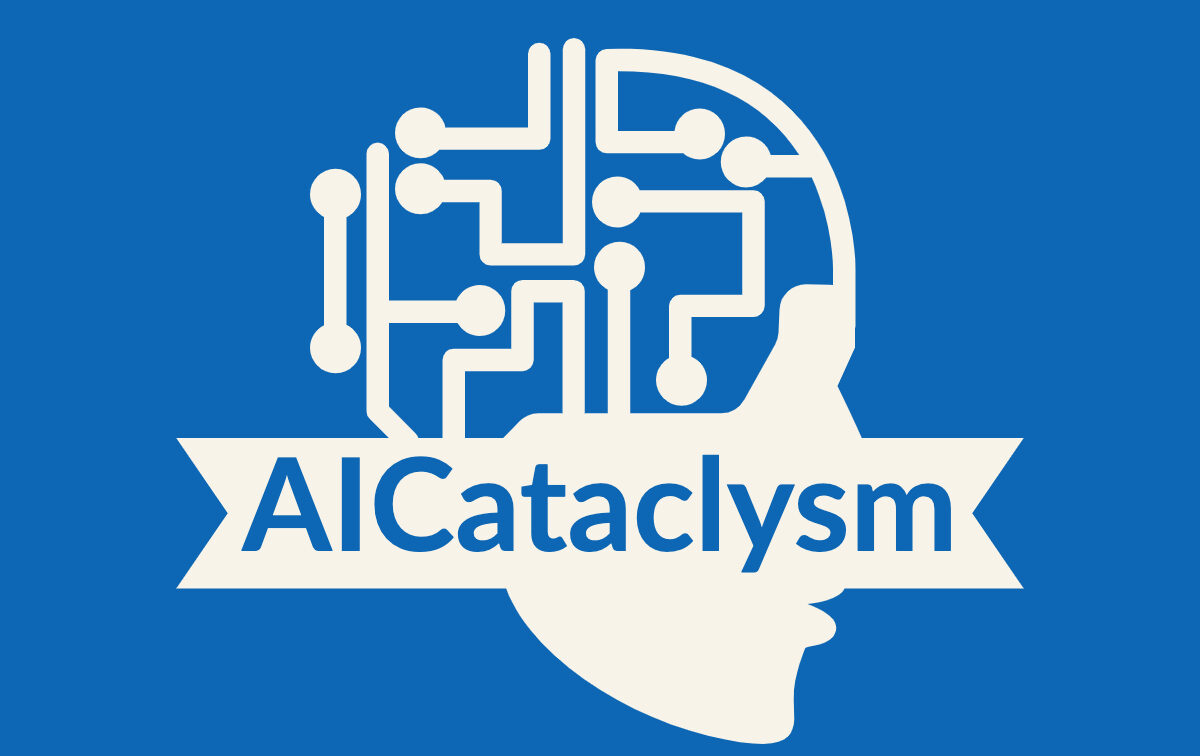Today, I’m excited to delve into the fascinating world of Artificial General Intelligence (AGI). In this comprehensive guide, we will explore what AGI is, how it differs from other forms of AI, and its potential to revolutionize industries and enhance human capabilities. So, fasten your seatbelts as we embark on this enlightening journey!
Key Takeaways:
- AGI aims to replicate human-level cognitive abilities in machines.
- AGI is versatile, adaptable, and capable of performing a wide range of tasks.
- It can learn like a human, excel across multiple domains, and exhibit creativity and problem-solving skills.
- AGI has the potential to revolutionize industries, solve complex problems, and enhance human abilities.
- Stay tuned as we explore further in this comprehensive guide!
What is AGI?
AGI, or Artificial General Intelligence, refers to a system or software that aims to replicate and mimic the cognitive abilities of a human being. Unlike narrow AI, which is designed for specific tasks, AGI is characterized by its versatility and ability to perform a wide range of tasks, just like a human. AGI is built on advanced AI techniques such as machine learning and deep learning, enabling it to learn from experiences, adapt to new situations, and teach itself new skills.
With AGI, we are striving to create machines that can think, reason, and problem-solve like humans. AGI has the potential to revolutionize industries, solve complex problems, and enhance human capabilities. By imitating human-level cognitive abilities, AGI could bring about significant advancements in various fields, from medicine and transportation to art and music.
The development of AGI is an ongoing process that requires the integration of key concepts and technologies such as machine learning, deep learning, and neural networks. These technologies enable AGI to learn, think, and adapt like humans. While AGI is still a work in progress, it holds immense promise for the future, offering exciting possibilities and opportunities for both society and individuals.
| AGI | Narrow AI | |
|---|---|---|
| Versatility | Capable of performing a wide range of tasks | Designed for specific tasks |
| Learning | Can learn from experiences and teach itself new skills | Lacks the ability to learn and adapt |
| Intelligence | Strives to replicate human-level cognitive abilities | Specialized in its designated domain |
| Creativity | Capable of generating new ideas and solving complex problems | Limited in creative thinking and problem-solving |
Human-like Learning
One of the key features of AGI is its ability to learn like a human. It utilizes advanced AI techniques such as machine learning and deep learning to learn from large amounts of data, identify patterns, and make decisions or predictions based on its knowledge. AGI can constantly grow, improve, and adapt just like a human does. This human-like learning capability sets AGI apart from other forms of AI.
AGI’s learning process involves the use of machine learning algorithms that enable it to acquire knowledge from various sources, including text, images, and videos. These algorithms analyze data, extract meaningful information, and build models that enable AGI to understand and solve complex problems. AGI also leverages deep learning, a subset of machine learning, to simulate the way our brains process information. This enables AGI to learn in a more complex and nuanced manner, allowing it to make connections and correlations that go beyond simple pattern recognition.
The ability of AGI to learn and adapt is crucial for its development and effectiveness. Through continuous learning, AGI can acquire new skills, update its knowledge base, and improve its performance in different domains. This learning process is iterative and dynamic, allowing AGI to refine its understanding, make better predictions, and solve increasingly complex problems. AGI’s human-like learning capabilities pave the way for exciting opportunities and advancements in various fields.
Benefits of AGI’s Learning Abilities
- Enhanced problem-solving: AGI’s ability to learn like a human enables it to approach complex problems creatively, thinking outside the box and generating innovative solutions.
- Efficiency and productivity: By constantly learning and improving, AGI can optimize processes, automate tasks, and increase efficiency in various industries, leading to enhanced productivity.
- Knowledge sharing: AGI’s learning capabilities allow it to acquire knowledge from different domains and share insights with humans, fostering collaboration and exchanging expertise.
- Adaptability and versatility: AGI’s ability to learn and adapt across different domains makes it a valuable tool in a variety of industries, from healthcare to finance to manufacturing.
“AGI’s human-like learning capabilities pave the way for exciting opportunities and advancements in various fields.”
Summary
AGI’s human-like learning capabilities set it apart from other forms of AI. Through machine learning and deep learning techniques, AGI can acquire knowledge, identify patterns, and make informed decisions. AGI’s iterative and dynamic learning process allows it to continuously improve, adapt, and solve complex problems. The benefits of AGI’s learning abilities include enhanced problem-solving, increased efficiency, knowledge sharing, and adaptability across different domains.
| Benefits | Advantages |
|---|---|
| Enhanced problem-solving | AGI can approach complex problems creatively and generate innovative solutions. |
| Efficiency and productivity | AGI’s continuous learning and improvement can optimize processes and increase efficiency. |
| Knowledge sharing | AGI can acquire knowledge from different domains and collaborate with humans, fostering knowledge exchange. |
| Adaptability and versatility | AGI’s ability to learn across domains makes it a valuable tool in various industries. |
AGI: Cross-Domain Mastery
Artificial General Intelligence (AGI) possesses a unique characteristic that sets it apart from other forms of AI: cross-domain mastery. Unlike narrow AI, which is designed for specific tasks, AGI has the ability to excel across multiple domains and apply its knowledge and skills to various areas. AGI can connect the dots between different fields, allowing it to come up with innovative solutions and tackle complex problems.
Imagine a world where AGI combines its understanding of biology with advanced computational power to develop breakthrough medicines. AGI’s expertise in physics could revolutionize transportation systems, designing more efficient and sustainable modes of travel. Furthermore, AGI’s proficiency in art and music could lead to the creation of awe-inspiring masterpieces that touch the depths of human emotion.
AGI’s interdisciplinary nature opens up endless possibilities for collaboration and advancements. By leveraging its cross-domain mastery, AGI has the potential to transform industries, drive scientific breakthroughs, and push the boundaries of human knowledge.
Benefits of AGI’s Cross-Domain Mastery
AGI’s cross-domain mastery brings a multitude of benefits. It enables efficient knowledge transfer between different fields, fostering interdisciplinary collaboration and accelerating innovation. The ability to combine knowledge from various domains allows AGI to tackle complex challenges that require a holistic approach.
By excelling across multiple domains, AGI can help solve pressing global issues, such as climate change, by leveraging the insights and expertise from diverse disciplines. AGI’s cross-domain mastery also enables it to provide comprehensive and well-rounded solutions, taking into account the interactions and dependencies between different areas.
Moreover, AGI’s cross-domain mastery can lead to serendipitous discoveries and unexpected connections between seemingly unrelated fields. By exploring uncharted territories at the intersection of different disciplines, AGI has the potential to unlock groundbreaking insights and pave the way for revolutionary advancements.
AGI: Unleashing Creativity and Problem-Solving Skills
Artificial General Intelligence (AGI) is not just about replicating human-level cognitive abilities, it is also about unlocking a new level of creativity and problem-solving. AGI possesses the capacity to generate innovative ideas, find solutions to complex problems, and even create original content in various forms. This ability sets AGI apart from other forms of AI and makes it a valuable companion for humans in exploring new frontiers.
With AGI, the boundaries of creativity are pushed further, as it can think outside the box and come up with novel ideas that may have eluded human minds. It has the potential to revolutionize industries by introducing groundbreaking concepts and approaches. For example, AGI could be instrumental in designing sustainable solutions to address climate change or developing novel strategies for optimizing resource allocation. The possibilities are endless.
Moreover, AGI’s problem-solving capabilities have the power to tackle complex challenges that surpass human capacity. By analyzing vast amounts of data, identifying patterns, and utilizing advanced algorithms, AGI can provide insights and solutions that were previously unattainable. This has significant implications across multiple domains, including healthcare, finance, and scientific research.
| AGI’s Creative Power | AGI’s Problem-Solving Skills | |
|---|---|---|
| Capability | Unleashing innovative ideas | Tackling complex challenges |
| Applications | Revolutionizing industries | Transforming healthcare and research |
| Potential Impact | Breaking new ground | Unlocking breakthroughs |
As AGI continues to evolve, its creative and problem-solving potential will become even more pronounced. However, it is important to consider the ethical implications and ensure that AGI aligns with human values. Strategies such as developing ethical guidelines, industry collaboration, and responsible implementation are essential in harnessing the full potential of AGI in a safe and beneficial manner.
AGI vs. Narrow AI
When comparing Artificial General Intelligence (AGI) and Narrow AI, it becomes clear that the two concepts differ significantly in terms of capabilities and scope. While Narrow AI is designed for specific tasks and excels within its narrow domain, AGI aims to replicate human-level cognitive abilities and possess versatility and adaptability across multiple domains.
AGI stands out with its ability to think abstractly, transfer learning from one domain to another, and exhibit a broader range of intelligence. Unlike Narrow AI, which is focused and limited, AGI can learn, adapt, and perform a wide range of tasks. It can connect the dots between different fields, make innovative connections, and solve complex problems.
Furthermore, AGI’s human-like learning capabilities set it apart from Narrow AI. AGI utilizes advanced AI techniques such as machine learning and deep learning to learn from extensive amounts of data, identify patterns, and make decisions based on its acquired knowledge. This ability to constantly grow, improve, and adapt makes AGI more akin to human intelligence.
The Distinction
“While Narrow AI is like a highly specialized expert in a specific field, AGI can be likened to a versatile polymath capable of excelling in multiple domains.” – AI Expert
To illustrate the differences between AGI and Narrow AI more clearly, the following table provides a concise overview.
| AGI | Narrow AI | |
|---|---|---|
| Definition | Replicates human-level cognitive abilities and adapts to various tasks and domains. | Designed for specific tasks and excels within a narrow domain. |
| Capabilities | Can think abstractly, transfer learning across domains, and exhibit a broader range of intelligence. | Focuses on a particular task or domain, lacking versatility and adaptability. |
| Learning | Learns like a human, using techniques such as machine learning and deep learning. | Relies on predefined algorithms and data patterns to execute tasks. |
As the development of AGI progresses, more differences between AGI and Narrow AI may emerge. However, the distinction in capabilities, learning methods, and adaptability laid out in this section helps to provide a clear understanding of the contrast between these two crucial aspects of artificial intelligence.
Key Concepts and Technologies Behind AGI
Artificial General Intelligence (AGI) is a sophisticated technology that encompasses various key concepts and advanced technologies. These concepts and technologies are instrumental in the development and realization of AGI’s potential. Let’s explore some of the crucial elements driving AGI’s progress.
Machine Learning
Machine learning is a fundamental component of AGI. It enables AGI systems to learn from data without explicit programming. Through machine learning techniques, AGI can analyze large amounts of information, recognize patterns, and make informed decisions or predictions based on its acquired knowledge. This adaptable and self-improving nature allows AGI to learn and grow, just like humans do.
Deep Learning
Deep learning is a subset of machine learning and is another essential technology in the AGI toolkit. Inspired by the human brain’s neural networks, deep learning algorithms can process and interpret complex data structures. This capability enables AGI to engage in more intricate and nuanced learning, resulting in a deeper understanding of the world around it.
Neural Networks
Neural networks are models designed to mimic the structure and functionality of the human brain. These interconnected nodes and layers of artificial neurons enable AGI to process information, recognize patterns, and perform tasks with human-like intelligence. By emulating the brain’s neural architecture, AGI can achieve a level of cognitive ability necessary for versatile problem-solving and creativity.
Summary
Key concepts and technologies like machine learning, deep learning, and neural networks form the foundation of AGI. These technologies empower AGI to learn, adapt, and reason in a manner that resembles human cognition. Ongoing research and development in these areas continue to push the boundaries of AGI’s capabilities, bringing us closer to the realization of this revolutionary technology.

The Road to AGI
As we delve into the future of Artificial General Intelligence (AGI), it’s important to recognize that the path to achieving AGI remains uncertain. While some experts predict that AGI could become a reality within the next few years or decades, others believe that it might take a century or more, or maybe even never fully materialize. The development of AGI is a dynamic process, filled with breakthroughs and challenges that shape its timeline.
Researchers and scientists are deeply engaged in the pursuit of AGI, pushing the boundaries of what is possible. However, the complexity of replicating human-level cognitive abilities in machines presents significant hurdles. These challenges include advancing machine learning techniques, creating more sophisticated neural networks, and developing frameworks that ensure AGI aligns with human values and ethics.
While we can’t accurately predict when AGI will be fully realized, what we do know is that the future of AGI holds immense potential and endless possibilities. The impact of AGI on society and various domains, from healthcare to transportation, cannot be overstated. It has the power to revolutionize industries, solve complex problems, and enhance human abilities, paving the way for a brighter and more efficient future.
Table: AGI Timeline Predictions
| Expert | Prediction |
|---|---|
| Ray Kurzweil | AGI by 2045 |
| Elon Musk | Within a decade |
| Nick Bostrom | In the next century |
| Andrew Ng | Not within our lifetime |
Table: AGI timeline predictions by experts in the field. These predictions highlight the diverse range of perspectives regarding the timeline for achieving AGI. It’s important to note that these predictions are speculative and subject to change as technology and research progress.
The Potential Upsides of AGI
Artificial General Intelligence (AGI) holds immense potential to revolutionize numerous industries and enhance human abilities across domains. The benefits of AGI are far-reaching and have the power to transform society in significant ways. Here are some of the key potential upsides of AGI:
Increased Problem-Solving Abilities
AGI’s advanced problem-solving capabilities can help tackle complex issues that are currently beyond human capacity. With its ability to analyze vast amounts of data and identify patterns, AGI can generate innovative solutions to pressing global challenges, such as climate change, disease prevention, and resource optimization.
Enhanced Efficiency and Productivity
AGI has the potential to revolutionize industries by optimizing workflows, automating repetitive tasks, and increasing overall efficiency. By taking on mundane and time-consuming tasks, AGI can free up human resources to focus on more creative and strategic endeavors. This can lead to increased productivity and economic growth.
| AGI Benefits | Examples |
|---|---|
| Innovative Solutions | AGI’s problem-solving abilities can help develop breakthrough medical treatments or design sustainable transportation systems. |
| Efficiency and Productivity | AGI can automate repetitive tasks, optimize processes, and increase overall productivity in various industries. |
| Collaboration with Humans | AGI can function as a valuable collaborator, complementing human skills and offering new perspectives to inspire innovative thinking. |
| Environmental Impact | AGI can contribute to creating a greener future by optimizing energy usage and modeling ecological systems for sustainable practices. |
Collaboration with Humans
AGI can function as a valuable companion and collaborator to humans, bridging knowledge gaps and offering fresh perspectives. By collaborating with AGI, humans can unlock new possibilities, challenge assumptions, and push the boundaries of creative thinking. AGI can be an invaluable partner in problem-solving, brainstorming ideas, and generating innovative solutions.
Potential for a Greener Future
AGI’s capabilities extend beyond traditional boundaries, making it a powerful tool for environmental stewardship. By optimizing energy usage and modeling ecological systems, AGI can contribute to creating a more sustainable future. AGI’s insights can enable more efficient resource allocation, reduce waste, and develop innovative solutions to mitigate the impact of climate change.
In conclusion, AGI has the potential to bring about numerous benefits, ranging from advanced problem-solving and enhanced productivity to transformative collaborations with humans and a greener future. While it is essential to address the risks and ethical dilemmas associated with AGI, harnessing its potential can lead to significant advancements across various domains and improve the overall well-being of society.
The Potential Dark Side of AGI
While AGI offers great promise, it also comes with potential risks and ethical dilemmas. As we delve deeper into the development and deployment of AGI, it is crucial to consider the potential negative impact it could have on society and individuals. Understanding and mitigating these risks is essential to ensure a responsible and beneficial implementation of AGI.
One of the key concerns surrounding AGI is the exacerbation of economic inequality. The concentration of AGI development resources in the hands of a few powerful entities could widen the gap between the haves and the have-nots. This concentration of power could lead to greater disparities in wealth and access to opportunities, potentially leaving many individuals marginalized and disadvantaged.
Another significant concern is the potential displacement of jobs. AGI’s ability to perform a wide range of tasks could render certain occupations obsolete, leading to unemployment and socioeconomic challenges. It is crucial to proactively address this issue by reevaluating our education systems and creating new pathways for individuals to adapt and thrive in a world powered by AGI.
The Ethical Dilemmas of AGI
“The development and deployment of AGI raise pressing ethical considerations, including questions of decision-making, transparency, and accountability.”
AGI’s decision-making capabilities also raise ethical dilemmas. As AGI becomes more autonomous and capable of making independent choices, we must ensure that it aligns with human values and ethical principles. The possibility of AGI making decisions that result in unintended harm or unethical behaviors is a significant concern that requires careful consideration and robust safeguards.
Furthermore, the existential risk of AGI is a topic of concern. While the likelihood of AGI developing harmful intentions or launching a doomsday scenario is low, the potential consequences of such an event are grave. It is crucial for the AGI research community to prioritize safety measures and adopt a collective responsibility to prevent any catastrophic outcomes.
| AGI Risks | AGI Ethical Dilemmas |
|---|---|
| Economic inequality | Decision-making |
| Job displacement | Transparency |
| Unemployment | Accountability |
| Concentration of power | – |
Addressing these risks and ethical dilemmas requires a collaborative effort from researchers, policymakers, industry leaders, and society as a whole. It is essential to establish ethical guidelines and regulatory frameworks that ensure AGI development and deployment adhere to human values, fairness, and transparency. By approaching AGI development with a focus on responsible innovation, we can harness its immense potential while minimizing the potential negative consequences.
As we navigate the uncharted territory of AGI, it is crucial to prioritize the well-being and welfare of humanity. By addressing the potential dark side of AGI and proactively mitigating associated risks and ethical dilemmas, we can strive towards a future where AGI enhances our lives, fosters societal progress, and upholds our core values.
Navigating the Alignment Challenge
When it comes to the development of Artificial General Intelligence (AGI), ensuring alignment with human values and ethics is a complex challenge that demands careful attention. As we strive towards creating AGI, it becomes essential to establish clear guidelines and frameworks that guide its behavior and decision-making processes.
The alignment challenge involves determining what values and principles should be prioritized in the development of AGI. We must carefully consider the potential unintended consequences and harmful behaviors that AGI might exhibit if not properly aligned with human values. To address this challenge, researchers and organizations are actively exploring various approaches and methodologies.
Organizations like OpenAI are at the forefront of AGI research and have placed a strong emphasis on developing AGI that is safe, effective, and aligned with human values. They recognize the importance of creating AGI that respects ethical guidelines and mitigates any risks that might arise.
As we navigate the alignment challenge, it is vital to foster collaboration and engage in open dialogue with experts across different disciplines. By drawing upon the expertise of ethicists, policymakers, and technologists, we can work towards developing AGI that benefits society in a responsible and ethical manner.






